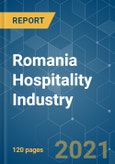Romania's economy is mainly centered on the services sector, which represents 58.2% of the GDP and employs around 49% of the nation's workforce. Tourism has been flourishing in recent years in the country reaching an all-time high of 13.26 million in 2019. In 2020, however, the number of tourists staying in Romania fell by 52.3%, because of the COVID-19 global restrictions. In 2020, Romania's tourism sector accounted for 3.69% of the country's GDP. There are a variety of relief features such as the Carpathian Mountains, the Black Sea, the Danube Delta, as well as a multitude of wooded areas, rivers, and lakes, which make the country one of the biggest tourist attractions in Europe. The hospitality industry in Romania is largely dependent on its tourism potential which can be bifurcated into two major components. First, the natural component is evident in its spectacular landscape, favorable climatic conditions for both summer and winter tourism, and presence of natural therapeutic spas. Second, the historical component of the tourist potential of Romania is represented by traces of succeeding civilizations that had lived on Romanian territory since ancient times, monuments and religious art objects, museums, and museum collections.
In the recent times, government has also shown its support for the development of the hospitality industry through adjustment of policies, tax cuts and financial incentives for promotion of destinations. Hospitality industry in Romania has huge potential and yet the industry is less developed compared to its other European counterparts and faces strong competition from other destination such as Hungary, Bulgaria, Czech Republic and Croatia.
The hospitality industry in Romania has not deviated from the European trend either, being severely affected by the COVID 19 crisis. With several thousand employees, restaurants focused on deliveries and package orders through their own platforms or partnerships with digital delivery platforms, but also on new lines of business, such as the creation of semi-prepared packages or special menus for certain occasions.
Key Market Trends
Increasing Tourist Arrivals is Driving the Market
Romania is a popular destination for mountain tourism. Romania’s natural potential encourages domestic tourism, particularly winter sports and ski tourism is anticipated to continue to drive tourism in the forecast period. Also, Romania is quietly emerging as an interesting European destination, owing to its unique ability to combine natural habitat with more leisure tourist activities. Mountain tourism is a part of Romania's tourist heritage, which is presently interpreted differently by visitors due to its unique appeal derived from natural, cultural, heritage, and social characteristics.
Romania recorded a total of 13 million tourists in 2019, ranking 37th in the world in absolute terms and figures have been steadily rising for both domestic and international arrivals. However, because of the coronavirus (COVID-19) outbreak in 2020, the number of tourist arrivals dropped by more than 50% compared to the previous year, totaling only 6.34 million people. Almost 50 % of foreign tourists from EU countries who visited Romania in 2020 came from neighbouring countries: Bulgaria and Hungary. In turn, 8.3% of foreign tourists came from Germany and 7.6 percent from Italy. However, Romania has reopened for tourism on June 1, 2021, now allowing visitors from all countries to enter, with different rules applying based on risk. The Romanian government suspended the ban on foreign nationals entering the country effective June 1st 2021 , which is likely to give a boost to the market studied.
Rising Number of Tourist Establishments in Romania
The increasing overnight stay by Romanians as well as foreign tourists in the establishment of accommodation is raising occupancy rates in accommodation establishments in Romania. Although the number of tourist inflow decreased in Romania from 13.37 million in 2019 to only 6.39 million in 2020, the number of various forms of accommodation establishments targeting tourists increased in Romania. For the year 2019, there were 8,402 accommodation establishments whereas for the year 2020 it increased to 8610. Out of 8610 establishments, 8336 were private establishments and 2370 were established as mountain resorts. These data shows private establishment in the mountain resort category is highest. The majority of tourist accommodation establishments in Romania had a three-star hotel rating in 2020 and only 142 tourist establishments had a five-star ranking.
Similarly, there was also a rise in the number of beds in the tourist accommodation. For the year 2019, there were 356562 beds in various forms of tourist accommodation whereas, the number of beds raised to 358119 for the year 2020. In 2020, hotels in Romania had a total accommodation capacity of 197,598 beds and camping sites also provided over ten thousand beds.
Competitive Landscape
The hospitality industry in Romania is a combination of chain hotels and many independent hotels in upscale and luxury, mid-scale, budget, and economy categories. Romania’s capital has one of the most developed hotel markets in the country, dominated by 4- and 5-star hotels. Some of the most important players in the Romania hospitality industry are Ana Hotels, Grand Hotel Italia, Continental Hotels, JW Marriott, Ramada Bucharest Parc Hotel, Accor Hotels, Radisson Hotel Group, Hilton Worldwide, Intercontinental Hotels Group, Relais & Chateaux, Hotel PRIVO, and Others.
Additional Benefits:
- The market estimate (ME) sheet in Excel format
- 3 months of analyst support
This product will be delivered within 2 business days.
Table of Contents
Companies Mentioned (Partial List)
A selection of companies mentioned in this report includes, but is not limited to:
- Ana Hotels
- Grand Hotel Italia
- Continental Hotels
- JW Marriott
- Ramada Bucharest Parc Hotel
- Accor Hotels
- Radisson Hotel Group
- Hilton Worldwide
- InterContinental Hotels Group
- Relais & Chateaux
- Hotel PRIVO
Methodology

LOADING...








